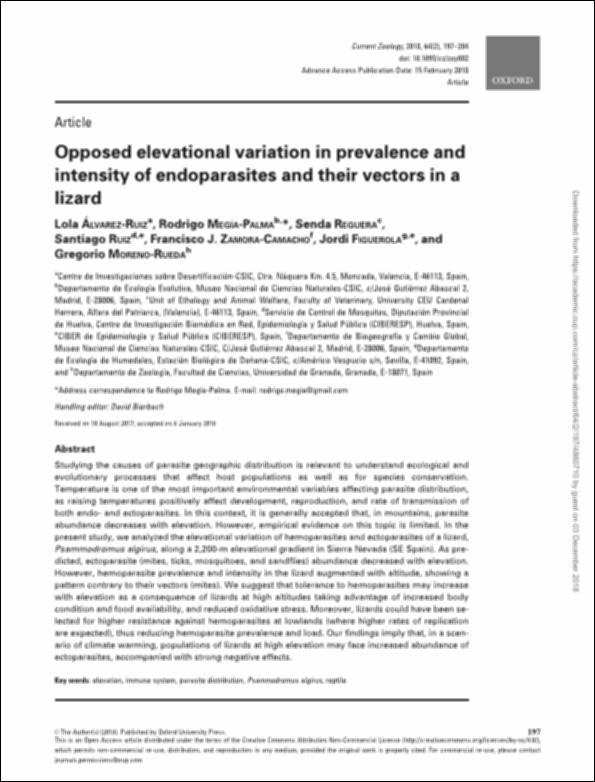Please use this identifier to cite or link to this item:
http://hdl.handle.net/10637/10160Opposed elevational variation in prevalence and intensity of endoparasites and their vectors in a lizard
| Title: | Opposed elevational variation in prevalence and intensity of endoparasites and their vectors in a lizard |
| Authors : | Álvarez Ruiz, Lola Megía Palma, Rodrigo Reguera Panizo, Senda Ruiz, Santiago Zamora Camacho, Francisco J. Figuerola, Jordi Moreno Rueda, Gregorio |
| Keywords: | Lagartos - Parásitos.; Lizards - Parasites.; Parasitología veterinaria.; Lagartos - Inmunología.; Lizards - Immunology.; Veterinary parasitology.; Veterinary immunology.; Reptiles - Enfermedades parasitarias.; Reptiles - Inmunología.; Reptiles - Parasites.; Reptiles - Parásitos.; Reptiles - Immunology.; Inmunología veterinaria.; Lagartos - Enfermedades parasitarias. |
| Publisher: | Oxford University Press. |
| Citation: | Álvarez Ruiz, L., Megía Palma, R., Reguera, S., Ruiz, S., Zamora Camacho, FJ., Figuerola, J. and Moreno Rueda, G. (2018). Opposed elevational variation in prevalence and intensity of endoparasites and their vectors in a lizard. Current Zoology, vol. 64, n. 2 (april), pp. 197-204. DOI: https://doi.org/10.1093/cz/zoy002. |
| Abstract: | Studying the causes of parasite geographic distribution is relevant to understand ecological and evolutionary processes that affect host populations as well as for species conservation. Temperature is one of the most important environmental variables affecting parasite distribution, as raising temperatures positively affect development, reproduction, and rate of transmission of both endo- and ectoparasites. In this context, it is generally accepted that, in mountains, parasite abundance decreases with elevation. However, empirical evidence on this topic is limited. In the present study, we analyzed the elevational variation of hemoparasites and ectoparasites of a lizard, Psammodromus algirus, along a 2,200-m elevational gradient in Sierra Nevada (SE Spain). As predicted, ectoparasite (mites, ticks, mosquitoes, and sandflies) abundance decreased with elevation. However, hemoparasite prevalence and intensity in the lizard augmented with altitude, showing a pattern contrary to their vectors (mites). We suggest that tolerance to hemoparasites may increase with elevation as a consequence of lizards at high altitudes taking advantage of increased body condition and food availability, and reduced oxidative stress. Moreover, lizards could have been selected for higher resistance against hemoparasites at lowlands (where higher rates of replication are expected), thus reducing hemoparasite prevalence and load. Our findings imply that, in a scenario of climate warming, populations of lizards at high elevation may face increased abundance of ectoparasites, accompanied with strong negative effects. |
| Description: | Este artículo se encuentra disponible en la página web de la revista en la siguiente URL: https://academic.oup.com/cz/article/64/2/197/4860710 |
| URI: | http://hdl.handle.net/10637/10160 |
| Rights : | http://creativecommons.org/licenses/by-nc/4.0/deed.es |
| ISSN: | 2396-9814 (Electrónico). 1674-5507. |
| Issue Date: | 15-Apr-2018 |
| Center : | Universidad Cardenal Herrera-CEU |
| Appears in Collections: | Dpto. Producción y Sanidad Animal, Salud Pública Veterinaria y Ciencia y Tecnología de los Alimentos |
Items in DSpace are protected by copyright, with all rights reserved, unless otherwise indicated.


